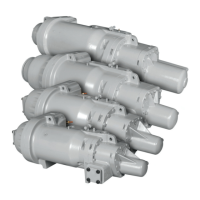15
Oil supply system components are shown in Fig. 9.
2.1 Oil Pressure Requirements
System pressure is used to generate the oil pressure
required to lubricate bearings and provide the oil that
acts as a seal between the screw rotors and the bores.
Oil pressure is monitored continuously during compres-
sor operation. The oil pressure must meet the following
criteria, based on P
DISCHARGE
, P
SUCTION
and
P
OIL
:
1. P
OIL
> [0.7 x (P
DISCHARGE
– P
SUCTION
) + P
SUCTION
]
2. P
OIL
> [P
SUCTION
+ 0.5 bar] 15 seconds after start
[P
SUCTION
+ 1.0 bar] 45 seconds after start
(Air-Cooled models; A in fifth digit of model number)
[P
SUCTION
+ 1.0 bar] 75 seconds after start
(Water-cooled models; W in 5th digit of model number)
The unit control system must monitor the oil pressure dif-
ferential, as well as the operating con
dition, so the com-
pressor can be shut down if the minimum requirements
are not met for any duration exceeding 15 seconds.
This time delay has two functions: first, to avoid nuisance
tripping during normal and transient operation, and sec-
ond, to allow the system sufficient time to develop pres-
sure differential during start-up.
The compressor must be shut down and prevented from
restarting when the
low oil pressure safety is tripped. The
safety should be a manual reset type that locks out com-
pressor operation until the system is serviced.
Carlyle offers a Compressor Protection Module package
to provide protection against loss of oil flow, reverse-rota-
tion and elevated discharge gas temperature.
2.2 Oil Separator Recommendations
The Paragon compressor requires an oil separator. The
combined oil capacity of the oil separator sump, the oil
reservoir, and the oil cooler, should be greater than the
values shown in Table 6.
The separator should be selected to provide a maximum
oil carryover leaving the separator required by that sys-
tem/application. Approximate oil flow versus compressor
pressure differential (Discharge Pressure - Suction Pres-
sure) is shown in Fig. 10. Additional oil ch
arge may be
required for systems that have longer tubing sets. See
Sections 9.1.1, 9.1.2, and 10.5 for additional information.
2.3 Oil Heater Recommendations for
Air-Cooled Models
For the typical oil separators used with the Paragon com-
pressor (see Table 6), a 500-watt flexible strip heater is
recommended. The heater should be wired to operate
when the compressor is OFF. This minimizes the migra-
ti
on of refrigerant to the oil stored in the sump. Figure 8
shows the minimum oil temperatures that must be main-
tained when the compressor is not operating based on
the outdoor ambient temperature (OAT). If the application
will allow refrigerant to collect in the compressor, then a
heater must be installed on the compressor. Running unit
water that is at least 20°F (11°C) below OAT, if possible,
can be used to prevent refrigerant from collecting in the
co
mpressor. Carlyle recommends that the oil tempera-
ture be monitored in warm climate applications and that
the oil separator heater be cycled off if oil temperatures
reach 190°F (88°C).
OIL
FILTER
OIL
SOLENOID
VALVE
CHECK
VALVE
OIL
SEPARATOR
HEATER
(BOTTOM)
OIL
LEVEL
SWITCH
(BOTTOM)
OIL
SHUTOFF
VALVE
Fig. 9 — Oil Supply System Components
a06-1685
Fig. 10 — Oil Supply at Compressor
0
1
2
3
4
5
6
0 50 100 150 200 250 300
Discharge - Sucon Pressure (PSID)
Typical Oil Flow Rate (GPM)
LEGEND
A/C — Air-Cooled
W/C — Water-Cooled
2.0 Medium/High Temperature System Oil Management
(R-134a, R-513A, R-1234ze)

